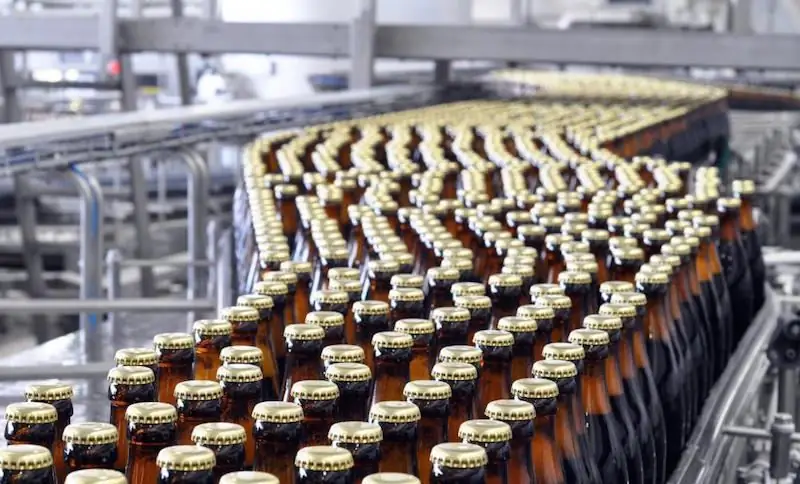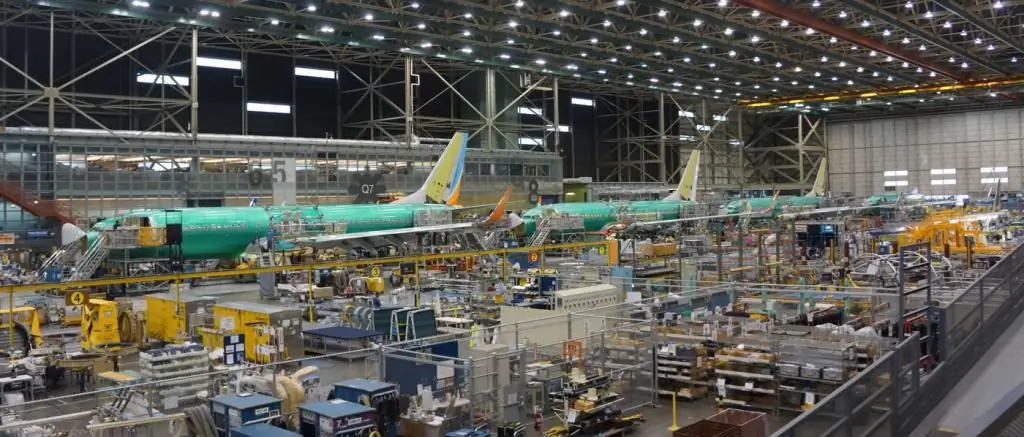2025 Author: Howard Calhoun | [email protected]. Last modified: 2025-01-24 13:10:38
Technological processes in industrial systems determine the structural elements of enterprises (sites, positions, individual jobs). Technically and economically efficient activity of the enterprise depends on the rational use of the units that make up its basis (skeleton). This is achieved in the process of creating and optimizing the production of processing systems (manufacturing companies).

What do you mean by structure?
This is a complex of various elements of an enterprise with their inherent parameters of the production environment (linear dimensions, production or repair volumes, information and technological connections, etc.). The analysis also considers the overall structure of the enterprise.
In addition to production, it includes functional departments (services) for managing design capacities, technological and financial reserves, as well as social elements that provide for the needs of workers and employees (canteens, shops, etc.).
Workplace
Is spatiala unit on which organizational and instrumental equipment, diagnostic tools and control over the implementation of technological stages, and the required equipment are located. Being the first link in the production chain (workplace - department - site - workshop - building), it has a significant impact on the structure of the production process and the final results of activities throughout the system.
The main reserves of production are concentrated in the workplace. The performance of the enterprise depends on the level of their organization, coordination of work, optimal location.

Production area
It is the next structural building block in building the necessary system for manufacturing products in the processing industry (forming the type of production structure). It consists of a set of departments (which, in turn, consist of jobs) and is designed to perform several technological stages, united by a common goal. In practice, there is a foundry section, an assembly section, a mechanical section, a turning section, etc. Separate sections, if necessary, are combined into workshops.

Production shop
Is the last step in the formation of a complete technological system for the production of finished products. The wagon painting workshop carries out a full range of preparatory (cleaning, priming), painting (applying several layers of paint) and final (applying signs, stamps) operations onmanufactured product.
Each workshop has its own management structure (shop manager, technologist, engineering apparatus, dispatching apparatus). If the number of shop workers exceeds 100 people, a shop accounting department is created. With a smaller number of employees, the service takes place in the general accounting of the enterprise.

Types of workshops
In practice, the whole variety of shop units is usually differentiated as main and auxiliary (servicing). A separate group is allocated by-production, which may be present in the presence of reserves of materials and capacities. They define the types of production structures in a particular enterprise.
The main workshops are formed to perform the main target function of production - the release of finished products based on the accepted manufacturing technology or repair (maintenance). Workers employed in the main workshops are also called the main ones (the main contingent). For example, the main workshops for railway enterprises (heavy engineering) include a dismantling workshop, a preparation and straightening workshop, a repair and assembly workshop, a car assembly workshop, a running gear workshop, and a painting workshop. As you can see, each of the listed structural units performs assembly or repair operations at the production facility itself, in this case, the car.
The correlation of one or another shop with the main one depends on the purpose of the enterprise. For example, a woodworking shop will be the main one at a woodworking enterprise and an auxiliary one at a manufacturing plant.automobile manufacturing.
Auxiliary workshops (service units) perform a supporting function for the main workshops and the entire enterprise as a whole. Repair of technological equipment, tools and accessories, loading and unloading operations, warehousing and storage operations, manufacturing of spare parts and components. Here is a far from complete list of work performed. Despite the subordinate position of auxiliary production in relation to the main one, its role cannot be overestimated. In addition, if we analyze the latest recommendations for optimizing production systems within the framework of logistics concepts, then innovations relate primarily to supporting processes.
Traditionally, they include instrumental, repair of electrical equipment of the enterprise, recycling, mechanical repair, repair and construction.
Side shops and production sites create products from surplus (waste) production. For example, enterprises with a large number of metal structures in production can produce metal gates, fences and consumer goods. Homestead farms are also being created, which provide the employees of the enterprise with food.
Considering the types of production structures, it is necessary to note the creation of groups of auxiliary units, which, as a rule, are combined into specialized farms, which makes it possible to centrally manage processes, pursue a unified technical policy and create conditions for in-depth specialization. On themachine-building enterprises, as a rule, five main farms are used.

Repair facilities
The structure of the production process includes a machine shop, an equipment repair area, and specialized workshops. The main functions are the repair of technological equipment based on the adopted system of repair and maintenance. The main tasks are the formation of a repair strategy based on the study of equipment repair cycles. Creation of a flexible system of influences on the machine environment (small and medium repairs, overhaul and overhaul maintenance). Maintenance of fixed assets of the enterprise in good condition. General management is carried out by the chief mechanic of the enterprise.
Tool economy
Structurally, administrative and production divisions are represented by a tool department, a tool shop, a central tool warehouse, tool distributing storerooms, utility rooms. The main functions are the manufacture and repair of tools, planning work to maintain the required level of tooling at the level of departments using a rational supply chain. The main tasks for the future are minimizing the cost of tool manufacturing, improving the control system and tooling production.
Transportation
It is represented by production infrastructure facilities that provide various transport operations and allow the movement of goods within the production system. Transportthe department, managed by the assistant to the head of the enterprise, develops rational schemes of transport routes (pendulum, beam, ring, etc.) based on the analysis of cargo turnover and the implementation of cargo flows. Optimizes the operation of external (cars on the company's balance sheet) and internal (elevators, cranes, autocars, conveyors) transport. The production company has at its disposal a transport workshop, car repair shops, garages.

Energy economy
Implementation of energy supplies to all production facilities. Interaction of energy networks of the enterprise with city highways. Analysis of energy losses. Monitoring the operation of transformer stations, boiler houses, boiler houses, thermal power plants. Subordinates to the chief power engineer of the enterprise. The structure of the economy may include a workshop for the repair of electrical equipment of the enterprise, various workshops.
Warehousing
Organizes the work of all types of storage units - open and closed warehouses, overpasses, storage facilities for fuel and fuels and lubricants. The main long-term tasks are the optimization of the warehousing system based on the use of advanced methods. It is the object of attention of modern logistics technologies.

Conclusion
Production structures are the basis for the formation of enterprises of any form of ownership. Their rational choice and study of the types of production structures directly affects the efficiency of production activities, flexibilitytechnological processes and the operation of technological equipment.
Recommended:
Stages of organization development. Organization life cycle

What do giants like McDonald's, Apple and Walmart have in common, besides having over 100,000 employees, is an interesting question. They all started small, with just a few people, and then grew. The stages of organizational development apply to domestic companies as well. All major manufacturers face transition periods. Basically, without government support and large investments, everything starts with small business
Essence and concept of organization. Form of ownership of the organization. Organization life cycle

Human society consists of many organizations that can be called associations of people pursuing certain goals. They have a number of differences. However, they all have a number of common characteristics. The essence and concept of organization will be discussed in the article
Inline production is Concept, definition, methods of organization and technological process

The production process is a complex technological action that can be organized in different ways and means. The work of an enterprise in the conditions of in-line production of products is today considered the most efficient, but at the same time demanding in terms of labor, organizational and material costs. In a general sense, in-line production is a format of production activity in which the principles of rhythm and repeatability of operations come to the fore
Flow methods of production organization: parameters, characteristics and standards. The need for this method in production

Today, in-line production is the most progressive form of organization of the production system. Optimal speed of work, minimum labor intensity and maximum quality of production - this is not a complete list of the advantages of the method under consideration
Production infrastructure: definition, organization methods, types, structure

The pace of economic development of modern countries is increasingly dependent on the structural structure of the national economy. The progressive development of social production cannot do without highly developed logistics with the effective functioning of all its components that also affect the sphere of management. The framework of this system is based on the production infrastructure (PI) as a whole, which determines the potential with resource funds for the economic development of the country

